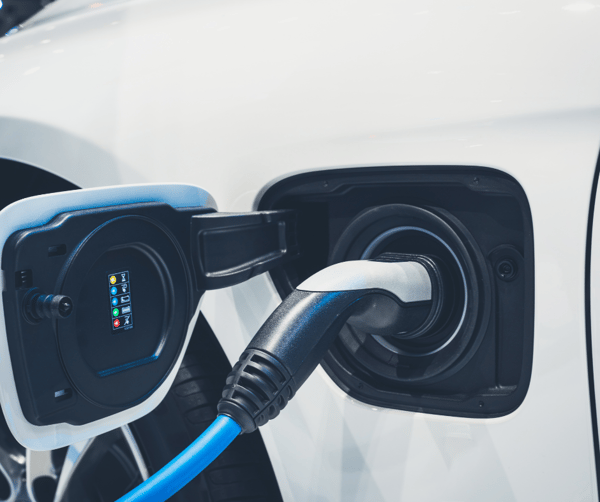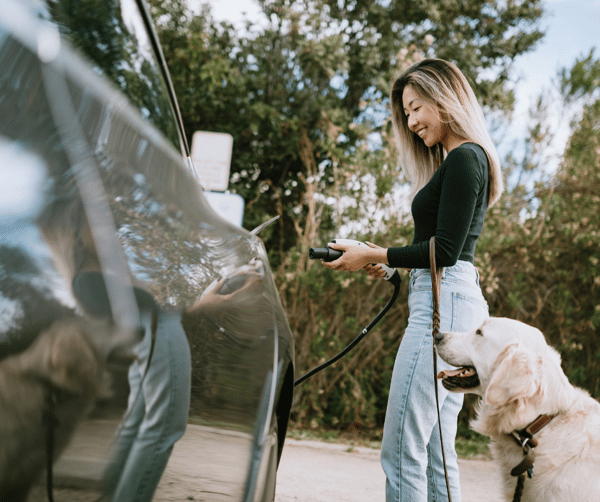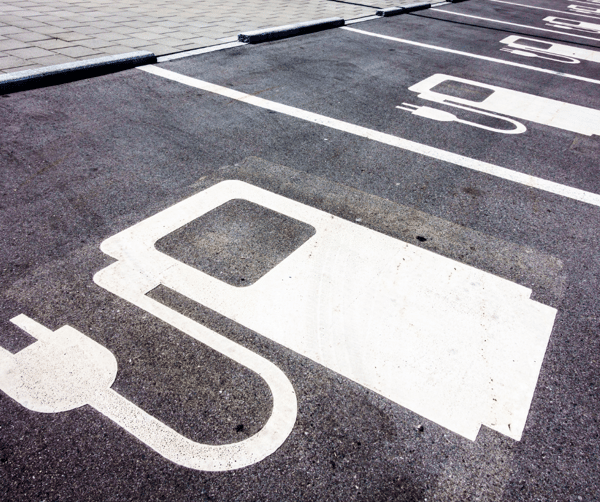Electric vehicles can be charged with solar panels. Solar panels create solar power. Solar power is utilised as electricity that can charge an electric vehicle. It's best to charge your electric vehicle during peak solar generation times. The best time for solar generation is 10 am - 2 pm.
Read on to find out how you can charge your electric vehicle with solar panels.
There are two things at record highs: fuel prices and electric vehicle (EV) sales. A coincidence? Probably not. Electric car sales have tripled in the last year, quickly taking up a meaningful market share of new vehicles. Several nations have also made plans to ban petrol car sales within the next two decades.
As new technology forces its way into the mainstream, infrastructure can struggle to keep pace. The current number of EV public charging stations isn't enough, although we can expect them to grow rapidly as the number of EVs on the road increases. The good news is that you don't have to wait – you can charge your electric car with your solar panel system!
How many solar panels do I need to support EV charging at home?
On average, around three or four solar panels produce 1kW of power, equating to approximately 4kWh of useable electricity. Of course, your system will produce more in summer than winter.
Like the fuel efficiency statistics of petrol and diesel cars, electric cars have the same barometer of statistics: kWh per kilometre. For example, the standard Telsa Model 3 Rear-Wheel Drive (chosen as it is the cheapest of the Model 3s) on average uses 15kWh/100km (or 0.15kWh per kilometre). This means you’ll get around 26.5km per day from your four panels.
Let’s compare this to the Western Australian daily driving average of 33km covered. You’ll only need a few more panels in order to produce enough energy to hit your everyday needs. However, it’s important to remember that this energy production will need to be factored in on top of what you need to run your house. There’s also energy lost in the transfer from your solar panels to your electric car – so make sure you’ve got more solar power capabilities than you need!
Plico has solar + battery systems large enough to accommodate both EVs and household electrical needs. When you have a battery, you can store your energy from peak generation periods, using it to charge your EV whenever you want.
What are the three levels of EV charging?
If you’ve got an electric car or are in the research stage of getting one, you’ve probably heard of the three levels of EV charging. Each level has a different speed and efficiency and involves differing equipment and power sources.
Level 1
This is probably what non-EV owners view charging to be – plugging your car into a standard household power socket, as you do with your television or toaster. And it’s not wrong; it is a method of charging your electric car, it’s just the least efficient method.
A standard household socket in Australia provides around 2kW of power. So, keeping the Tesla Model 3 Rear-Wheel Drive as our case study, it would take about thirty hours to fully charge the 60kWh battery.
Another factor worth bearing in mind is that if you need to charge your EV for thirty hours, you’ll be going through the night and unless you have a large solar battery, you’ll be pulling (and paying) for energy off the grid.
Level 2
Level 2 charging is a more efficient and effective home charging system with a higher upfront cost. It involves purchasing and installing a charging station in your home, which usually costs between $1000 – $2500 for your charger and an additional $800 or more for installation.
Level 2 charging stations can provide up to 7.2kW of power, which means that the Tesla Model 3 could be fully charged in just under eight and a half hours.
Level 3
Unlike level 1 or 2 charging, level 3 charging uses direct current (DC) electricity and is the fastest method of charging your electric vehicle. Public charging stations are the way you can utilise level 3 charging, a process that can provide anywhere between 50kW to 400kW of power. So the Tesla Model 3 would take around an hour or less to charge from empty to full.

How long will it take to fully charge my electric car at home?
The time it takes to fully charge your electric car at home will depend on various factors.
The first is the size of your EV’s battery. EV battery storage varies with brand and model. They can range as far as 17kWh (PHEV) to 100kWh. The smaller the battery, the quicker you’ll be able to charge it all the way up (and the sooner you’ll find yourself having to recharge it).
As we’ve already touched on, the equipment you use to charge your EV matters as well. Level 1 charging will take longer than level 2. As highlighted above, with the Tesla Model 3 as our example, level 1 charging will take around thirty hours to charge the 60kWh battery in its entirety. Level 2 charging should take just under eight and a half hours.
Can I use my solar battery to charge an electric car at night?
Yes, you can! With a solar + battery system in the daytime, when the sun is beaming, you can move the excess energy you don’t need to your battery, accumulating it to use whenever you need it. This includes when you need to charge your electric car!
It’s best to charge your EV during the day, while the sun is at its brightest and warmest. This helps prevent you from draining your solar battery’s resources, as you’ll need that electricity to power your home in the evening, saving you the costs of pulling your power off the grid. Having a solar battery also gives you the confidence of increased energy independence – if you’re in desperate need of power for your car, your battery could save the day.
How does the size of my EV's battery affect charging times?
As this article has already referenced, the unit kilowatt-hours (kWh) will most likely describe the size of your electric vehicle's battery. The bigger your EV’s battery, the more power it will take to fully charge it, therefore the more it will cost you. However, it will take you further before needing to be recharged.
Whether you’re using level 1, 2 or 3 charging, each piece of equipment will have a capped charging efficiency. So if you’ve chosen an EV with a large battery size, such as the Lucid Air (118kWh) or the Rivian R1T (135kWh), you’ll want to be charging your battery with at least level 2 charging but you’ll likely end up finding yourself at level 3 public chargers. Keep reading to find out where all Western Australia’s public chargers are!

Do I need three-phase power to charge an EV?
The short answer is no. But if you want three-phase power for other applications within your home, utilising it to charge your EV could triple the speed at which it charges.
Most houses are on single-phase power, and ordinarily, this is enough for our daily electrical needs. However, for larger homes and businesses, three-phase power offers more power for their increased demand.
Three-phase power costs a few thousand dollars to install. With this in mind, the quicker charging times you’ll receive from three-phase power probably won’t outweigh the extra expense.
How much does it cost to charge an electric car?
Compared with petrol and diesel cars, electric vehicles are cheap to run. As mentioned, fuel prices are formidably high at the moment, and there’s collective uncertainty as to if or when they will begin to fall.
Cost of charging your electric vehicle
Here’s the fantastic news: if you have a capable solar energy system or access to a free public EV charger (some will charge you), you can power up your electric car for free! That sure beats paying $2.20 for fuel, doesn’t it?
But if you want to charge your EV at home using grid energy, it’s still extremely affordable. On average, in Western Australia, it costs around $0.29 per kWh to charge your electric car at home. Using the Tesla Model 3 Rear-Wheel Drive as our example, which has a 60kWh battery, charging the entire battery would cost you about $12.
The Model 3 Rear-Wheel Drive’s ‘real range’ is 380km, so if we take the previously mentioned Australian daily driving distance of 33km, a full charge of your Model 3 will last you over ten days! Which would work out at just over a dollar a day.
At the time of writing, the average petrol price in Western Australia is $1.76 per litre. On average, in Australia, a car’s fuel consumption is about 7.5km per litre of petrol (this number, of course, goes up and down depending on the vehicle). So going off this number, the daily cost of petrol is about $7.74, far higher than the 2020 Tesla Model 3.
How much do EVs cost?
Brand new electric cars are comparable in cost to their petrol and diesel counterparts. They can range in price from $45,000 to $200,000 – fairly innocuous prices in relation to the market. Costs that are made even better If you’re in a state that’s offering rebates and incentives.
Are there any EV rebates or incentives?
Let’s start with the possibility of getting some cash in your pocket just for buying an electric car. Every Australian state (in May 2022, Western Australia joined the party!) has incentives for making your next car electric. Some of these include $3000 rebates, no stamp duty and free registration. Have a look at the ABC’s article for information specific to each state.
Western Australia's Premier, Mark McGowan, has just announced a $3,500 rebate for the first ten thousand state residents to purchase an electric or hydrogen vehicle under $70,000.
How much money can I save by charging my EV with solar power?
You can save a significant amount of money by charging your electric vehicle with solar power. These savings are on top of the financial benefits of choosing an electric car. Here at Plico, we’ve helped hundreds of Australians save on their energy bills and become more energy independent with solar power. When you have a solar + battery system, your energy from the sun is free! And in sunny Australia, there’s lots of it.
The hurdle that most Aussies will face is finding the money to purchase their solar and battery system. The upfront cost can be over $20,000. Plico wants to make it as easy as possible for everyone to integrate renewable energy into their lives. That’s why we’ve disrupted the market and created a model where our members don’t pay any big upfront costs for having a solar + battery system. Our qualified local experts install your system without the hefty price tag, and we provide ongoing support and monitoring for ten years.

Where are all the EV charging stations located in Western Australia?
While EV charging stations are only just starting to make their first steps toward the inevitable ubiquity currently experienced by fuel stations, a growing number are still up and running. Knowing where they are is an essential part of owning an electric car – you don’t want to run out of juice and get stuck somewhere!
RAC has an interactive map where you can view all of Western Australia’s charging stations, from shopping centres to caravan parks to roadhouses. Have a look at the page to get an idea of how many charging stations we currently have in Western Australia.
Solar and EVs are the future
If you’re not creating your electricity through renewable resources, your electricity harms the environment. Greenhouse gases are a by-product of the creation of this electricity, and as we know, greenhouse gases are responsible for much of the turbulent destruction that goes by the name of climate change. The two primary considerations that nudge people to buy electric cars are the same ones that provoke them to switch to solar: to save money while helping the environment. By combining a solar + battery system with an electric vehicle, you can maximise your savings – savings that will passively accumulate over time – while increasing your energy independence and taking the burden off the environment.
The IPCC recently released their latest report on the state of climate change. Have a read of our article for further information, but the summary is this: we need to act now. The future is energy independent households who are creating and using their energy through renewable sources. Combining a solar + battery system with your EV means that you’re in control of the process and ahead of the crowd.
Curious whether a Plico solar + battery system could save you money? Get in contact with one of the friendly, switched-on Plico team members to find out how much you could save or use our Solar Power Savings Calculator to get an idea.
If you want to learn more about solar, read our article on the different types of solar batteries.
Have a question about solar + battery?



